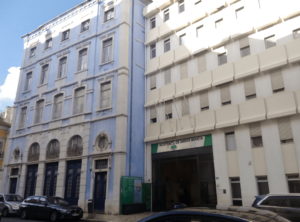Hospital de Santa Marta facts for kids
Quick facts for kids Hospital de Santa Marta |
|
|---|---|
| Central Lisbon University Hospital Centre | |
 |
|
| Geography | |
| Location | Rua de Santa Marta, Santo António, Lisbon, Portugal |
| Coordinates | 38°43′25″N 9°08′44″W / 38.7235°N 9.1456°W |
| Organisation | |
| Care system | National Health Service |
| Funding | Public hospital |
| Hospital type | Group III (Central Hospital) |
| Patron | St Martha of Bethany |
| Services | |
| Emergency department | No |
| History | |
| Founded | 1890 |
Hospital de Santa Marta is a public hospital in Lisbon, Portugal. It is often called "Saint Martha's Hospital." It is part of a larger group of hospitals known as the Central Lisbon University Hospital Centre. This hospital group is owned by the state.
The building where the hospital is now used to be a nunnery. A nunnery is a place where nuns (women who dedicate their lives to religious service) live. For much of the 1900s, it was a major school for Internal Medicine. This is the study of how to treat diseases inside the body. More recently, it has become very well-known for treating heart problems. It specializes in Cardiology (heart care) and Cardiothoracic Surgery (heart and chest surgery). It is one of the most important centers in Portugal for diagnosing and treating heart diseases.
Contents
A Look at the Hospital's Past
From Asylum to Convent
In 1569, King Sebastian allowed a safe place to be built. This place was called an asylum or Recolhimento. It was for girls whose families had been affected by a big sickness called the Great Plague of Lisbon. The asylum was named after Saint Martha.
A few years later, the priests asked for the asylum to become a nunnery. In 1577, Pope Gregory XIII agreed to this. The nunnery would follow the rules of Saint Clare. In 1583, the convent was officially started. The first nuns came from other convents in Portugal.
Building the Convent Church
The buildings that were already there were changed. They became a church and a monastery. The new church was built between 1612 and 1636. It was designed in a style called Mannerism.
Today, you can still see many beautiful old tiles, called azulejos, from the 1600s and 1700s. These tiles are around the cloister (a covered walkway) of the hospital. In 1693, Catherine of Braganza, who was once Queen of England, lived next door. She had a special viewing area built to attend church services.
The Great Lisbon Earthquake
In 1755, a huge earthquake hit Lisbon. It destroyed most of the city. The convent was badly damaged. The nuns had to live in tents while the building was repaired. Even with the damage, Santa Marta was one of only eleven convents that could still be used.
Becoming a Hospital
In 1833, after a civil war, the government decided to close many monasteries. Female convents, like Santa Marta, were allowed to stay open. They could remain open until the last nun living there passed away. For Santa Marta, this happened in 1887. After that, the building became government property.
In 1890, the building was quickly turned into a hospital. This was to help with a flu sickness that was spreading. In 1903, it became part of Lisbon's main hospital system. This system was first called "Saint Joseph's Hospital and Annexes." Later, in 1913, it was renamed the "Civil Hospitals of Lisbon."
Between 1905 and 1908, the hospital was greatly improved. It was updated with 700 beds, an operating room, and an outpatient clinic. It also got a lift and electric lights. In 1910, it was named "Hintze Ribeiro Hospital." It also became connected to the Lisbon Medical-Surgical School. In 1911, after a big change in government, it was renamed the "Lisbon Faculty of Medicine Teaching Hospital." It gained more control over its own management in 1922.
Later, in 1953, a new hospital called Saint Mary's Hospital became the main teaching hospital in the city. Santa Marta Hospital was updated again in the late 1950s. New sections for heart care and surgery were added. In 1971, a new building was added for patient visits and administrative offices.
Images for kids


